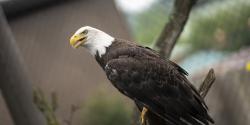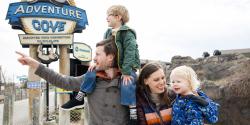NOTE TO MEDIA: A media kit (including images and b-roll) is available here. Photo credits are contained in the file name (example: Grahm S. Jones, Columbus Zoo and Aquarium). All manatee activities conducted under USFWS permit #61585C.
POWELL, OH – While she may not have calves of her own, Stubby the manatee rarely spends Mother’s Day alone. That’s because for more than two decades, Stubby has acted as a surrogate mother, providing a little motherly TLC to dozens of orphans coming to Columbus Zoo and Aquarium for continued rehabilitation. And this Mother’s Day is no different.
Affectionately known as “the Aquatic Queen of Columbus Zoo,” Stubby voluntarily serves as the official greeter to new arrivals at the Manatee Coast habitat in the Zoo’s Shores and Aquarium region, taking youngsters in need of a mother’s touch under her flipper as they learn how to be a grown-up manatee.
“There is one face all regulars to the Zoo’s Manatee Coast habitat are familiar with, and that’s Stubby,” said manatee keeper Dan Nellis. “She’s the matriarch at Manatee Coast, and she makes our job easier thanks to the excellent guidance she provides to raise other manatees.”
Stubby came to Columbus in 2005 after losing 70% of her paddle to a boat strike. Unfortunately, due to the injuries she sustained, she is considered to be a conditionally non-releasable animal. Her condition is evaluated every five years to determine if she is ready or not to return to Florida, but it is unlikely that she will move out of this category.
“Stubby shows the newbies the ropes,” Nellis said. “She nudges them to the surface to breathe and gives them a full tour of the main aquarium. She helps them find the food and is there for a snuggle when needed.”
As part of the Manatee Rescue & Rehabilitation Partnership (MRP), the Columbus Zoo and Aquarium is a second stage rehabilitation facility that provides a temporary home for manatees until they are ready for release back to the wild. The MRP is a cooperative group of non-profit, private, state, and federal entities who work together to monitor the health and survival of rehabilitated and released manatees and provide tracked data.
Manatees in the wild often need help after facing natural and man-made threats, including exposure to red tide, cold stress, disease and, like Stubby, boat strikes – events that also can leave young manatees without essential motherly support.
“When you find these orphans alone, it’s really important to help give them a second chance at survival,” said Becky Ellsworth, the Columbus Zoo’s Shores and Aquarium curator. “The Columbus Zoo has a long history with orphaned calves who require some help growing into young manatees. We have a tremendous and devoted care staff, but we also are extremely lucky to have Stubby to provide care that only a mother can.”
She added that young manatees are dependent on their mothers for the first two years of life to feed from and to just learn how to be manatees.
One orphan named Squirrel that was especially attached to Stubby recently completed her rehabilitation journey and returned to Florida waters after successfully growing to a young adult and healthy weight under the watchful eye of her care team and, of course, Stubby.
“Squirrel stuck to Stubby like glue – just like a mother and calf in their native range,” Ellsworth said of the orphan, who was only 66 pounds when she was initially rescued and still only 116 pounds when she arrived in Columbus. “That tiny girl would sleep on Stubby’s back; they were a package deal.”
But as time passed, Squirrel did what all mothers prepare their youngsters to do: She grew stronger and more confident, demonstrating she could live independently. A little over three years after being rescued by the Florida Fish and Wildlife Conservation Commission and rehabilitated through the MRP at the Miami Seaquarium and Columbus Zoo, Squirrel completed her final rehabilitation stages at SeaWorld Orlando and was released with a couple of her gal pals at Blue Spring State Park in Volusia County, Fla., where the water is warm and well-fed manatees are plentiful.
“By the time Squirrel left Columbus, she had changed so much,” Ellsworth said. “Weighing nearly 1,000 pounds and adept at making her way around, Squirrel was ready and showing signs that she could be a capable mother just like Stubby.”
But Squirrel’s release did not mean Stubby’s job was over – far from it. Stubby is currently playing mom to a pair of males who arrived last fall, Mr. Dobak and Nighthawk. Both were rescued from Charlotte County, Fla., and are benefiting from a mother’s touch as they continue their rehabilitation.
“Mr. Dobak and Nighthawk are both a bit shy,” Ellsworth said. “They take their cues from Stubby, eating when she eats and resting when she rests. They are learning the routine and will be big, strong, confident males soon.”
When the boys are eventually ready to be released in Florida waters, Stubby will be ready for them to move on as well.
“When orphans leave, they are ready – and so is Stubby,” Ellsworth said. “As soon as the older manatees leave, new ones come in and Stubby is once again ready to do her part. She has never been trained to do this—she completely does this on her own. As much as our care team does for these precious babies in need of rehabilitation, Stubby does an incredible job preparing them for success in ways that only another manatee can. On Mother’s Day—and every day—we are beyond grateful for her nurturing, selfless nature; all that she teaches the calves, our team, and our guests; and the positive impact she’s making for the future of her species.”
For additional updates about the Columbus Zoo’s conservation initiatives, events, and more, follow the Zoo’s social media accounts on Facebook, Instagram, X, and TikTok, and visit us at ColumbusZoo.org.
###
About the Columbus Zoo and Aquarium
Home to more than 10,000 animals representing over 600 species worldwide, the Columbus Zoo and Aquarium leads by making a positive impact on people, wildlife, and wild places. The Zoo complex is a recreational and education destination that includes the 22-acre Zoombezi Bay water park and 18-hole Safari Golf Club. The Columbus Zoo and Aquarium also manages The Wilds, a 10,000-acre conservation center and safari park located in southeastern Ohio. The Zoo is a wildlife conservation organization with regional, national and global impact, annually supporting conservation and research projects locally and worldwide. For more information, please visit ColumbusZoo.org.









